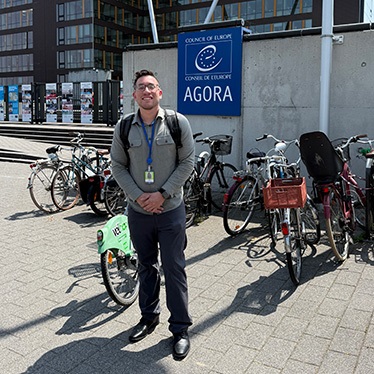‘Unearthing Africa's Long Lost Past’: Maxwell Professor Unearths England’s First Outpost
October 2, 2023
The remarkable discovery of Fort Kormantine by archaeologist Christopher DeCorse illuminates a critical period in Atlantic history.
Back in 2019, Syracuse University archaeologist Christopher DeCorse was part of a team that made an unexpected discovery during fieldwork in coastal Ghana. While excavating the ruins of the 17th-century Dutch Fort Amsterdam, the researchers from Syracuse, the University of Rochester and the University of Ghana unearthed trade materials suggesting they may have found the location of an older English fort, Kormantine—England’s first outpost in Africa, built in 1631, and one of the earliest that sent enslaved Africans to the new colonies in the Americas.
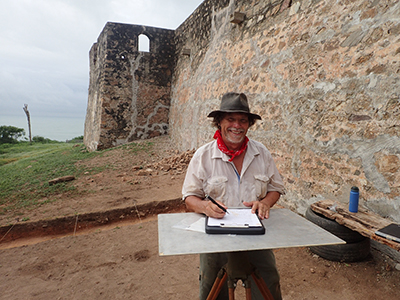
Discovering a site of such historical import would be a major development, but the pandemic delayed further investigation until the summer of 2023, when DeCorse was able to return to Ghana to lead an extensive excavation. The Distinguished Professor and chair of the Maxwell School Anthropology Department was supported by a $21,000 CUSE grant and an award from the National Endowment for the Humanities (NEH) topping $125,000.
Joining DeCorse’s project were several Maxwell School anthropology students and alumni, including Samuel Amartey ’15 M.A. (Anth)/’21 Ph.D. (Anth), a Ghanaian national and currently a lecturer at the University of Ghana, Legon, who served as the project field director; Sean Reid ’22 Ph.D. (Anth), a research associate and lecturer at the University of Virginia; and doctoral candidate Matthew O’Leary.
The initial results were disappointing when the crew began to excavate for further evidence of the English fort this past June: they found more 17th-century artifacts, like ceramics and tobacco pipes, but mingled with plastics and other materials from 20th-century restoration projects.
Then Omokolade Omigbule, a Nigerian graduate student at the University of Virginia, dug a little deeper. “Suddenly he got down to a level with a very clear sizeable wall, almost three feet across, running diagonally across the room, and there was a clearly intact red clay floor,” DeCorse recalls. “We knew immediately: we have the wall of a fort that’s on a dramatically different orientation from the existing ruin. Although I believed traces of the fort would be present, the discovery of the massive, earlier wall was a huge surprise.”
Word of the breakthrough spread quickly, prompting a visit from BBC News and inquiries from other international media outlets. As the excavation continued, they found more and more clues to Kormantine’s long-buried past. “What we essentially uncovered,” says DeCorse, “were things that encapsulate the entire early history of this fort.”
OUTPOST OF EMPIRE
Kormantine’s history involved numerous transformations as it grew from a small trading lodge into a more substantial outpost, and a new community of Africans, attracted by trade opportunities, established the adjacent town of Abandze.
The original outpost burned down in 1640—possibly sabotaged by the Dutch—and the English replaced it with a strengthened stone fort. During the later stages of this summer’s excavation, DeCorse recounts, “We found a layer that was very dark with charcoal and may relate to the earliest outpost that was destroyed.”
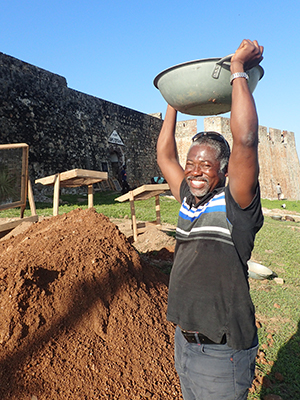
These remarkable findings illuminate a critical period in Atlantic history. “This is really the first scramble for Africa,” explains DeCorse, a member of Maxwell’s anthropology faculty since 1992. “At this point in the 17th century, European nations are scrambling for colonies and for outposts in Africa, trying to take advantage of the trade that the Portuguese had been dominating. And it’s at this time on the Gold Coast when slaves replace gold as the major trade item.”
The Kormantine site provides important keys to better understanding this era, and the cultural and economic interactions between Africans and Europeans through an early outpost of empire. While there are documentary references to the fort, descriptions of its location and construction are very limited, DeCorse says; the only image of the early fort is a sketch by Jean Barbot, a French commercial agent on slave ships.
Over the summer, DeCorse and the team uncovered several artifacts that offer insights into early 17th-century life at the fort. Small glass medicine bottles are one example. “This was an area where the death rate among arriving Europeans was very, very high—something like 60 percent of newly arrived Europeans on the coast died,” says DeCorse. “These medicine bottles and ointment jars would have been from trying to treat people with diseases that they were unfamiliar with.”
While media coverage of the Kormantine discovery, including the BBC report published in August, focused on the English fortification and its role in the slave trade, Samuel Amartey, the Ph.D. alumnus who was DeCorse’s student, notes that the African artifacts from the site are equally enlightening.
“We found several quern grinders, stone axes and ceramics,” he says. “They shed light on local practices and interactions between the British and local people. These items were likely used for food procurement and processing to support the fort’s garrison and crew members. To me, these materials show the complexities of European-African interactions.”
The European trade materials, which are well documented and can be precisely dated, help archaeologists assess the ages of African pottery and other materials that are otherwise difficult to pinpoint. “So now we have a corpus of really interesting, distinctive, African-made ceramics that we can date, and we can look at neighboring sites and have a way of dating those as well,” DeCorse explains. “This then aids our interpretation of the impacts of the European trade.”
REFINING CHRONOLOGY
One of DeCorse’s favorite finds from across his career as an archaeologist is a locally made tobacco pipe from Kormantine that incorporates a stem from a European pipe. He unearthed it during the initial excavation in 2019. “It indicates this sort of cultural syncretism—a combining of European and African elements,” he says.
DeCorse has worked in West Africa for more than 40 years, focusing on transformations in Africa during the period of the Atlantic trade. Thirty years ago, he established the Central Region Project as a hub for archaeological work in Ghana. To date, the project has encompassed work on hundreds of archaeological sites and yielded eight dissertations at the University alone.
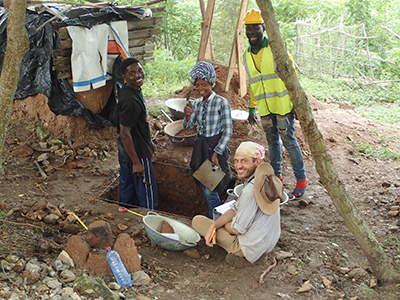
“The discoveries at Fort Amsterdam/Kormantine play into this broader project about understanding change and transformation in coastal Ghana over the past several millennia,” says DeCorse. “We now have sites dating back four or five thousand years, and this allows us to see what really happened with the advent of European trade and when enslaved Africans were taken out of this area. It really is in changing patterns of settlement. So, again, the ceramics from Fort Kormantine will allow us to refine that chronology when we look at these transformations.”
The work at Kormantine is far from complete. At the end of July, the team backfilled the site to protect it from the elements and other disturbances to the fragile structures until work can resume next summer.
Many of those who worked with DeCorse over the summer plan to continue with the project. Sam Amartey, who is currently teaching courses on archaeology and heritage management at the University of Ghana, says, “We will continue analysis and excavations next summer, and probably in 2025.”
Sean Reid, DeCorse’s former student now at the University of Virginia, notes that some deposits uncovered this past summer may indicate yet a deeper level of history: they found what appear to be ground stone celts, called nyame akuma, that predate the fort and may represent a pre-Atlantic component of the site. “This is what attracted me to the project and what I was hoping to identify,” he says. “We are still in the process of discussing, interpreting and dating these earlier archaeological contexts, which we will hopefully be able to sort out in the coming year.”
In the future, people across the globe will be able to virtually visit Fort Amsterdam and the excavations. DeCorse is a collaborator on a separate NEH-funded project, “Black Past Lives Matter: Digital Kormantin,” directed by the University of Rochester’s Michael Jarvis, that is creating a virtual tour of the site to be offered online.
Along with the ongoing work on the Kormantine site, DeCorse plans to publish short reports on the findings, to be followed by more detailed publications once excavations are complete. He is also fundraising for the project—the NEH grant requires $20,000 in matching funds from outside sources to unlock the full amount.
And in late September, DeCorse returned to Ghana—not to dig, but to share the story of the remarkable Kormantine discoveries with a film crew and reporters from CBS.
By Jeffrey Pepper Rodgers
Published in the Fall 2023 issue of the Maxwell Perspective
Related News
School News

Dec 4, 2025
Commentary

Dec 3, 2025
School News
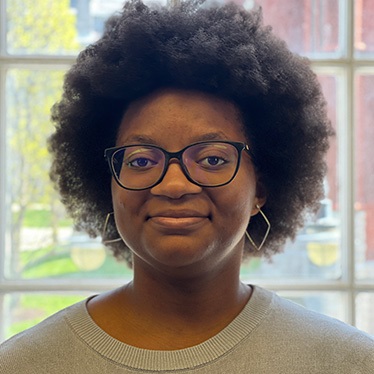
Nov 25, 2025
